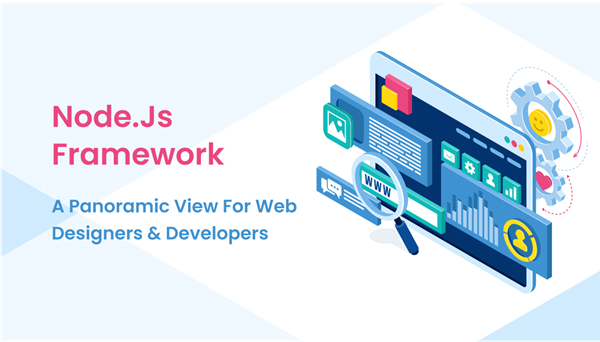In recent times business owners are incessantly looking for ways to drive the growth of their businesses, and web application development seems to be the most viable option with the advancement of technology. Expanding the reach without any physical outlet can be possible by availing the services of web applications 24/7.
The rapid transformation in the digital environment has resulted in the adoption of modern web applications by many organizations to survive in the fierce competitive marketplaces. Web applications have a very significant role in maintaining the business’s competitive edge. These applications are a combination of functionalities to facilitate a smooth experience for users. JavaScript is the most common programming language that web applications use to make web pages interactive.
For the first 20 years, JavaScript was mainly used for client-side scripting, and thereby developers had to take the initiative to work on multiple languages and frameworks between the front-end and back-end components. Later came Node.js to boost the business operations and profit due to its good handling of simultaneous connections. Using Node.js for back-end development enhances scalability and is considered a game-changing high-performance application to drive large traffic to the websites. Thereby modern organizations hire Node.js Developers to boost traffic to their websites.
Node.js Framework – Why it is Popular
Created by Ryan Dahl in 2009, Node.js is a single-threaded, open-source, and cross-platform runtime environment to create fast and expandable server-side applications. Running on Google’s V8 JavaScript Engine, the event-driven and non-blocking I/O architecture of the Node.js framework makes it an efficient and suitable real-time application. The built-in libraries of this framework are efficient enough to handle a large number of web requests and responses.
The developers are also increasingly favoring Node.js due to its difference from those of conventional server-side programs. Node.js is most convenient to developers as they can execute JavaScript on the server-side too, which means the front-end and back-end programming languages are the same.
Mainly the programmers and developers seek a responsive web design as an increasing number of organizations are adopting this characteristic to optimize the look, feel, performance, and accessibility of each device. Due to its cross-platform runtime environment feature, Node.js helps web programmers build various server-side applications based on JavaScript.
The key performance indicators for web servers are scalability, latency, and throughput. It is very difficult to keep the latency low and throughput high while scaling up and out. As a JavaScript runtime environment, Node.js adopts a non-blocking approach to server requests for achieving low latency and high throughput.
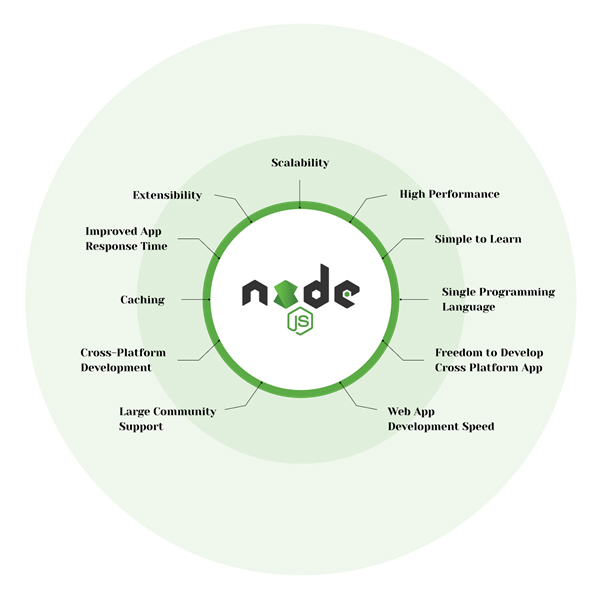
Node.js framework runs single-threaded, non-blocking, asynchronous programming, which is very much memory-efficient. However, the following metrics make the Node.js popular among the developers-
- Easy-to-learn feature
- Using JavaScript as the main language for web application development
- Powered by Google Chrome’s V8 engine, Node.js is lightning fast
- Based on event-driven architecture, the asynchronous nature of Node.js facilitates running on a single thread compared to other web technologies, where a new thread is spawned for every client request. Hence, this lightweight framework enables the foundation of non-blocking I/O criteria.
- Single language for all layers – for other web technologies, developers need to know multiple languages, like VB.NET, Java, or C#, to write code on the server-side. So, all the functions require two languages – one on the server-side and the other on the client-side. At the same time, Node.js requires only JavaScript for both clients and server-side. As such, web developers can interact only in a single language across the layers, and for any type of future communication it can be reused without any limitation.
- High Performance and Scalability – Renowned organizations like PayPal, Wal-Mart, and LinkedIn report exponential increase in the requests count per second and a significant reduction in the response time.
- It can be hosted anywhere – Considering the exponential growth, various cloud-based hosting providers and web servers support web applications based on Node.js. Google, Amazon AWS, Microsoft Azure, and many others are some of them.
- Ideal for real-time applications – For real-time applications development like chats and gaming apps, Node.js facilitates some extraordinary features. Besides, the event-driven and non-blocking nature is the best solution provider for all these types of programs.
- Smart sharing – The built-in Node Package Manager (NPM) helps in creating effective solutions as it includes a repository of 50,000 packages. With the help of NPM, the developers can update, share, and reuse the codes with utmost ease and accuracy. Hence, with its smart sharing feature, Node.js provides robust and consistent solutions.
- Advanced-Data Streaming – Developers can get benefits by using the data streaming feature of Node.js. For example, processing files during their upload will be reduced. Further, this feature is very beneficial during real-time audio or video encoding.
- Easy for modification and maintenance – Traditional applications become less adaptive with new requirements. Whereas building new web applications with Node.js is much easier. Instead of a single, large application, Node.js helps build many small applications. It is easy for the developers to modify or add new functionalities without making code-based changes.
- Act as a Proxy Server – Node.js framework provides effective support in case the enterprise lacks the professional proxy infrastructure. Using a server-side application for any specific purposes like communicating with 3rd party resources, storing images, and/or data collection, Node.js perfectly acts as a Proxy Server.
Here is a look at the beneficial aspects of Node.js-
Node.js Architecture and How it Works
By using a ‘Single-Threaded Event Loop’, the Node.js architecture can be able to handle multiple clients. In addition to these, exceptionally customizable and scalable features work in favour of the organizations. Hence, in recent times, modern organizations hire dedicated Node.js Developers to boost traffic to their sites and also for customer retention. The following diagram will give an overview of the Node.js architecture-
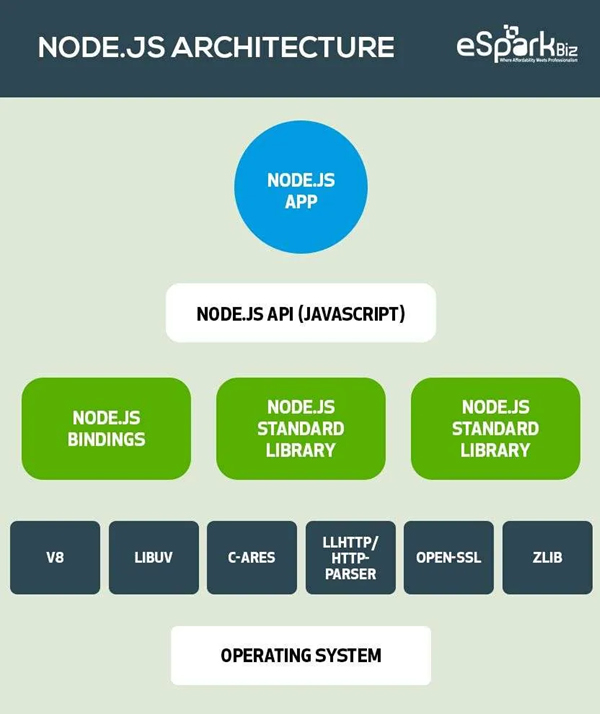
Node.js runs on Google Chrome’s V8 JavaScript engine, where web applications are event-based and asynchronous. In contrast to other architectures, Node.js handles simultaneous requests with its single-threaded model. The following diagram will give an overview of how the Node.js architecture is different from the traditional ones-
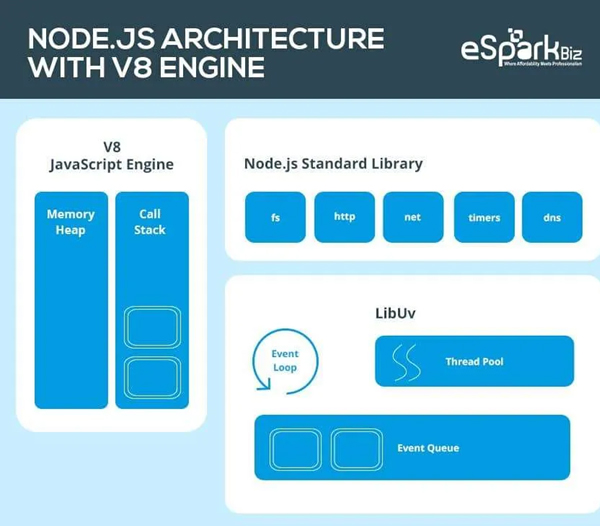
The platform of Node.js follows a simplified model than the multi-threaded traditional frameworks for clients’ requests/responses. In Node.js, a specific library called ‘Libuv’ provides the event loop mechanism and thereby, in this framework, the processing model is a combination of the JavaScript event-based model along with the callback mechanism.
In comparison to traditional web application techniques, Node.js is beneficial for developers. The single-threaded model does not overload the RAM system and simultaneously handles thousands of concurrent requests. Below the steps are provided to understand how Node.js works differently-
- Managing a specific thread lot to serve clients’ requests
- Placing the requests in a queue as soon as they come
- After this, the single-threaded event loop, the main component of Node.js, arrives. The event loop holds for the requests indefinitely.
- As soon as the request comes, the event loop selects the request from the sequence and assesses whether or not it requires the restriction of the input/output (I/O) operation. The loop will immediately process the call and send the response, if not.
- If the call has to perform a blocking action, a thread is assigned by the event loop for processing the request. Due to the existence of minimum internal threads, the auxiliary threads batch is also known as the worker group.
- However, the event loop traces the blocking requests and aligns them in a sequence once the requests are processed. In this way, the Node.js framework maintains a non-blocking structure.
Since Node.js uses fewer threads, fewer resources/memory are utilized, resulting in faster task execution. As the single-threaded architecture functions like multi-threaded architecture, Node.js is useful for real-time applications. For all these reasons, modern organizations use Node.js architecture for their websites to fulfil their targets more effectively.
Node.js Modules – A Look into this Aspect
In JavaScript, modules play an important role. If the organizations like, they can include the module, which consists of a group of functions, in the applications. As various Node.js modules are available in the open-source library, this facilitates the task of web development with the framework in a trouble-free way. A record of modules of built-in Node.js is provided here with their descriptions-
- assert – furnish a set of declaration or assertion tests
- buffer – deals with binary data
- child_process – works on a child process
- cluster – breaks down a single one into several node processes
- crypto – manages OpenSSL functions of a cryptographic structure
- dgram – facilitating the execution of UDP datagram sockets
- dns – it performs DNS lookups and name resolution functions
- events – it manages events
- fs – it is responsible to deal with the files
- http – helps Node.js to operate as an HTTP server
- https – helps Node.js to behave as an HTTPS server
- net – it creates servers’ side and client’s side
- os – furnishes particular information about the operating system
- path – deals with the paths of the file
- querystring – manages the strings of URL query
- readline – responsible for handling readable streams single line at a time
- stream – manages data streaming
- string_decoder – decodes or breaks the buffer objects into comprehensive strings
- timers – performs a function after receiving a number of milliseconds
- tls – executes the protocols of TLS and SSL
- tty – facilitates classes used by a text terminal
- url – analyses the URL strings
- util – permits the users to access the functions related to utilities
- vm – put together the JavaScript code in a virtual machine
- zlib – compresses and decompresses files
Due to these useful modules, adopting the Node.js framework by large organizations for web application development is the best option. Hence, the organizations should look to shift to Node.js to achieve high performance, scalability, and fast speed on their sites.
Node Package Manager (NPM) and its Useful Modules
Along with the basics of Node.js, the built-in support for package management using NPM is an inevitable criterion. However, the NPM is the most popular package library with millions of downloadable elements as per specific requirements. Open-source developers around the world use NPM to share or borrow packages. Also, many organizations utilize them for private development. With each version update, Node.js keeps adding remarkable features to enhance the performance and improvise the analysis.
The following ‘Top Useful NPM Modules’ help the developers to create web applications with many essential elements, like high performance, automated time-consuming tasks, robust routing, and super-high test coverage-
- #NPM: Express.js
- #NPM: Meteor.js
- #NPM: Koa.js
- #NPM: Nest.js
- #NPM: Mongo.js
- #NPM: Sails.js
- #NPM: Hapi.js
- #NPM: Total.js
- #NPM: Loopback.js
- #NPM: Socket.js
Node.js Latest Version
By successfully replacing the previous version, the latest version of Node.js (Node.js v18) will be released in the next six months (updated on May 10, 2022) and will be available with some unique features. After that, it will be promoted to Long-term Support (LTS) in October 2022. Node.js v18 will be supported until April 2025. Some of the unique features are-
- New globally available browser-compatible APIs
- fetch (experimental): By default, in Node.js v18, an experimental global fetch API is available. Comes from undici, the implementation is inspired by node-fetch, originally based upon undici-fetch.
- Web Streams API (experimental) – The experimental implementation of the Web Streams API is now available on a global basis
- Test runner module (experimental)
- Build-time user-land snapshot (experimental)
- V8 10.1 – Google Chrome’s V8 engine is updated to version 10.1, a part of Chromium 101.
Due to varied features, like enhanced buffer security, the latest NPM packages, and others, the Node.js latest version is extremely useful for modern organizations. Thereby, businesses can enhance the performance of their sites with the latest updates.
The Practical Usage of Node.js
By familiarizing themselves with the Node.js framework, features, and beneficial aspects, the developers can be able to implement this concept in the following areas-
- Single Page Applications
- Data-Intensive Real-time Applications (DIRT)
- Data Streaming Applications
- JSON APIs-based Applications
- I/O bound Applications
As such, if the organizations in recent times want to execute web application development to boost the traffic to their sites and achieve high performance, they should apply this framework in their applications. The following diagram will give an overview of the Real-time applications of the Node.js framework-

Node.js – A Key Statistics on Usage and Market Share
As per the recent update, Node.js is continuing to be the most popular web framework for web app development. Further, it is listed on Github as the second most popular project, with over 70,000 stars. Most surprisingly, the demand for Node.js developers has surpassed the PHP developers, the oldest one and the most prevalent web technology. So, the trend is obvious that in the coming days also, the organizations will give priority to Node.js as the preferred choice for web application development.
Reasons for using Node.js apps by the famous organizations
With the Node.js frameworks, the topmost organizations around the world have been able to solve a list of production challenges. Some of these are platform-related, while others concentrate on resource utilization. As the recent report by Hackernoon, companies like Netflix, PayPal, and LinkedIn all agree to savings of loading time up to 60%. The following diagram will give an overview of the top reasons behind the companies’ usage of Node.js apps-
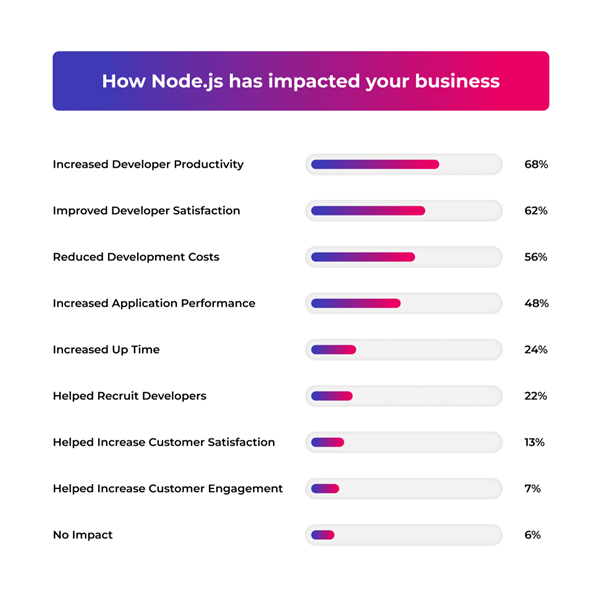
The reasons like better developer productivity, lower development cost, and higher app performance top the list.
Domination of following Top Node.js Trends in 2022
The following will be a brief description of each-
- Real-time Applications – 2022 will remain as a trailer of Node.js’s real-time applications’ demand. The domains like aviation, the industrial sectors and healthcare also require real-time applications based on Node.js to solve the critical problems in their sectors.
- Going Serverless – Cloud computing services have become mainstream for modern organizations. Due to the emerging trend of going entirely serverless, most businesses prefer to deploy the entire application service in public or private clouds. This results in a considerable cost decrease and an increase in the availability of web applications.
Node.js quickly accommodates microservices architecture. The robust architecture and APIs in Node.js can be quickly deployed on the cloud servers. Hence, it will facilitate improved response time, high-performing cloud servers, and a significant decrease in development expenses. Thereby it becomes an ideal choice for the organizations to go Serverless.
- GraphQL – This is the latest graph-based database structure. The data is saved on vertices in this type of database, and the nodes or edges perform as keys.As it is a graph-based database, it is easier and quicker to store and retrieve data from GraphQL. As the developers are pretty comfortable with GraphQL, the use and demand for this database have multiplied. As with GraphQL, the speed of performance is quite fast, and this becomes an ideal choice for applications based on Node.js.
- Growing Usage of MEAN and MERN Stack – For creating web applications, it is easier to handle the whole operation when both the frontend and backend includes JavaScript. The MEAN and MERN Stacks offer this benefit. The MEAN Stack relates to MongoDB, which has collaborated with Express, Angular, and Node.js. As such, it is an ideal choice for large enterprises. In this case, you can create super-fast and single-page-based web applications to deal with transfer of data on a real-time basis and manage updates easily. As Node.js is using both of these stacks, a positive trend among the organizations can be observed regarding the usage of Node.js.
- IoT Development – As it is a futuristic technology, IoT applications can process huge amounts of data. For which it needs a quicker and scalable language. Node.js seems to be most compatible with IoT technology. Due to the Covid impact, companies are increasingly adopting IoT technology to empower their factories and decrease dependency on manpower. The features of Node.js power the IoT applications and become an ideal choice for modern organizations.
From the above, it can be easily stated that modern organizations, in the coming years, will prefer Node.js to achieve high performance and scalability.
Market Position of Node.js
Some of the popular companies using Node.js are Uber, Netflix, Twitter, PayPal, Medium, LinkedIn, Trello, BBC, Nasa, eBay, Wal-Mart, Yahoo, Amazon Web Services (AWS), Microsoft, SAP, and others.
The Node.js framework is being used by different categories of websites (according to the last update)-
- Business & Industry (20.09%)
- Internet & Telecom (7.64%)
- Arts & Entertainment (7.56%)
- Shopping (4.65%)
- Others (60.06%)
However, according to the last update, the Node.js usage by the websites, the nation-wise category is –
- United States (26%)
- India (10%)
- Germany and Canada (6%)
Node.js dominates the world of web application development due to various features. The recent update also shows that in the coming years, more organizations will adopt this framework to achieve high performance at less cost. Hence, the demand for Node.js developers will rise more as almost every organization only prefers to hire Node.js Developers.
Final Thoughts
Following the trailer, the Node.js framework will be an ideal choice for organizations in the coming days, and for these reasons, the popularity of Node.js developers will also increase with time. In comparison to traditional PHP language, web designers and developers will prefer Node.js due to its efficiency, high performance, and real-time applications.
Moreover, the post-pandemic era emphasizes high performance with less manpower and development expenses. Thereby, the cloud services by Node.js become an effective choice for organizations as well as developers. In addition to this, the single-threaded and event-driven asynchronous architecture makes this framework an ideal option for web designers and developers to develop web applications and coding.
Advanced caching and data streaming, Microservices, scalability, speed, technical support, SEO-friendly nature, and a well-rounded community are some additional features that make Node.js a favourite to web designers and developers.
They can give more productive work as Node.js, powered by the V8 engine, provides a cross-platform and open-source runtime environment, including package management, unified APIs, native bindings, and threading. In conclusion, we can say that due to rising demand, the organizations will use Node.js to survive in the competitive marketplace.


